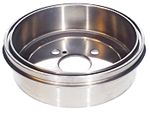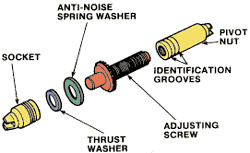The brake drum is the part of the drum brake system that fits over the wheel lug studs. It rotates with the wheel and is contacted by the brake shoes. When the brakes are applied, the wheel cylinder plungers expand and move the brake shoes outward causing the brake shoes to rub against the brake drum for slowing or stopping of the vehicle. The brake drum also absorbs and dissipates much of the heat generated by the braking process.

Carefully check the surface of the brake drum. Exploded view of a brake adjuster assembly.
Exploded view of a brake adjuster assembly.
See below the latest solved brake problems :-
Brake Bleeder Screw Function?
http://repairhelpcenter.blogspot.in/2012/02/brake-bleeder-screw-function.html
Replacing ABS unit on Buick Century?
http://technoanswers.blogspot.in/2012/02/replacing-abs-unit-on-buick-century.html
Brake pedal is pulsating and vibrating?
http://repairhelpcenter.blogspot.com/2012/01/brake-pedal-is-pulsating-and-vibrating.html
All types of brake problems and repairs
ABS light stays on but brakes work fine?
VCS maintenance required on Toyota Camry?
VCS and ABS lights go on and off intermittently on Lexus?
ABS & Brake lights warning indicator steady on dash and speedometer not working for Dodge Ram?
Isuzu rodeo speedometer is jumping?
http://schematicsdiagram.blogspot.com/2012/01/isuzu-rodeo-speedometer-is-jumping.html
E-brake is stuck down on Ford Focus?
http://schematicsdiagram.blogspot.com/2011/12/e-brake-is-stuck-down-on-ford-focus.html
Brake warning light comes on and car will not start intermittently?
http://repairhelpcenter.blogspot.com/2011/12/brake-warning-light-comes-on-and-car.html
When the car stops, abs pump turns ON?
Where is Power Brake Booster located on 1995 Lincoln Town Car?
http://howtobyme.blogspot.com/2011/12/where-is-power-brake-booster-located-on.html
Sometimes ABS light comes on while Driving?
How Anti-Lock Brakes Work?
Brake System Troubleshooting?
Car Brake lines have no pressure?
Car Brakes Dragging?
Car Brakes grabbing?
http://repairhelpcenter.blogspot.com/2011/12/car-brakes-grabbing.html
Car Brakes Making Noise?
http://repairhelpcenter.blogspot.com/2011/12/car-brakes-making-noise.html
Car Brakes Pulling?
http://repairhelpcenter.blogspot.com/2011/12/car-brakes-pulling.html
Pulsating Brake Pedal?
http://repairhelpcenter.blogspot.com/2011/12/pulsating-brake-pedal.html
Spongy brake pedal?
http://repairhelpcenter.blogspot.com/2011/12/spongy-brake-pedal.html
Hard Brake Pedal?
http://repairhelpcenter.blogspot.com/2011/12/hard-brake-pedal.html
How to Disconnect Power to EBCM on
http://schematicsdiagram.blogspot.com/2011/12/how-to-disconnect-power-to-ebcm-on.html
Where is ABS/TCS module located on 2005 Cadillac Deville
http://schematicsdiagram.blogspot.com/2011/12/where-is-abstcs-module-located-on-2005.html
How to Replace Power Brake Booster on 1996 GMC Jimmy?
Isuzu Trooper Shifts hard and Engine Revving in stop?
http://schematicsdiagram.blogspot.com/2011/12/isuzu-trooper-shifts-hard-and-engine.html
What is Brake Bleeder Screw?
http://repairhelpcenter.blogspot.com/2011/12/what-is-brake-bleeder-screw.html
How to replace car Brake Cable?
http://repairhelpcenter.blogspot.com/2011/12/how-to-replace-car-brake-cable.html
How to Replace Brake Disc?
ABS motor keeps running?
http://schematicsdiagram.blogspot.com/2012/01/abs-motor-keeps-running.html
Anti-lock brake light stays on all the time?
http://technoanswers.blogspot.com/2012/01/anti-lock-brake-light-stays-on-all-time.html
Is it necessary to replace Brake caliper while replacing rotors and brake pads?
http://repairhelpcenter.blogspot.com/2012/01/is-it-necessary-to-replace-brake.html
Emergency brake Adjustment for Hyundai Tiburon?
http://schematicsdiagram.blogspot.com/2012/01/emergency-brake-adjustment-for-hyundai.html
How does Brake Backing Plate works?
http://repairhelpcenter.blogspot.in/2012/02/how-does-brake-backing-plate-works.html
How to replace control panel on Audi A4 models?
How to inspect, service and replace brake shoe liner?
http://repairhelpcenter.blogspot.in/2012/02/how-to-inspectservice-and-replace-brake.html
See below how it looks :----

The details to inspect brake drum is as follows :----
Scored drum surface/Bell-mouthed drum/Concave drum/Convex drum/Hard spots on the drum/Threaded drum surface/Heat checks/Cracked drum/Out-of-round drum
All complaints related to brake performance must be carefully considered. The number one complaint is brake noise. Noise is often the first indication of wear or problems within the braking system, particularly in the mechanical components.
All complaints related to brake performance must be carefully considered. The number one complaint is brake noise. Noise is often the first indication of wear or problems within the braking system, particularly in the mechanical components.
- Rattles, clicking, grinding, and hammering from the wheels when the brake is in the unapplied position should be carefully investigated. Be sure the noise is not caused by the bearings or various suspension parts. If the noise is coming from the brake assembly, it is most likely caused by worn, damaged, or missing brake hardware, or the poor fastening or mounting of brake components. Grinding noises usually occur when a stone or other object becomes trapped between the lining material and the rotor or drum.
- When the brakes are applied, a clicking noise usually indicates play or hardware failure in the attachment of the pad or shoe. On recent systems, the noise could be caused by the lining tracking cutting tool marks in the rotor or drum. A nondirectional finish on drums eliminates this and so does a less pointed tip on the cutting tool used to refinish drums.
- Grinding noises on application can mean metal-to-metal contact, either from badly worn pads or shoes, or from a serious misalignment of the caliper, rotor, wheel cylinder, or backing plate. Wheel cylinders and calipers that are frozen due to internal corrosion can also cause grinding or squealing noises.
- Before inspecting drum brakes, place the vehicle in neutral, release the parking brake, and raise the vehicle on the hoist.
- Once the vehicle is raised, mark the wheel-to-drum and drum-to-axle positions so the components can be accurately reassembled.
- Relieve all tension from the parking brake cable by loosening or removing the adjusting nut at the equalizer.
- To access the drum brake assembly, remove the lug nuts and pull the wheel off the hub.
- Be sure to inspect the rear wheel axle gaskets and wheel seals for leaks.
- One of the most important safety inspections to be made is that of the brake drum.
- First, visually inspect the brake shoes, as installed on the car. their condition can many times reveal defects in the drums.
- If the linings on one wheel are worn more than the others, it might indicate a rough drum. Uneven wear from side to side on any one set of shoes can be caused by a tapered drum.
- If some linings are worn badly at the toe or heel, it might indicate an out-of-round drum.
- To finish your brake inspection, you'll have to clean the brake parts using the instructions below.
- Clean the backing plates, struts, levers, and other metal parts to be reused using a water-dampened cloth or a water-based solution. Equipment is commercially available to perform washing functions of brake parts. Wet cleaning methods must be used to prevent asbestos fibers from becoming airborne.
- Carefully examine the raised shoe pads on the backing plate to make sure they are free from corrosion or other surface defects that might prevent the shoes from sliding freely. Use fine emery cloth to remove surface defects, if necessary. Clean them thoroughly.
- Check to make sure that the backing plates are not cracked or bent. If so, they must be replaced.
- Make sure backing plate bolts and bolted-on anchor pins are torqued to specifications.
- If replacement of the wheel cylinder is needed, it should be done at this time. to determine wheel cylinder condition, carefully inspect the boots. if they are cut, torn, heat-cracked, or show evidence of excessive leakage, the wheel cylinders should be replaced.
- If more than a drop of fluid spills out, leakage is excessive and indicates that replacement is necessary.
- Disassemble the adjusting screw assembly and clean the parts in a suitable solvent.

- Make sure the adjusting screw threads into the pivot nut over its complete length without sticking or binding.
- Check that none of the adjusting screw teeth are damaged.
- Lubricate the adjusting screw threads with brake lubricant.
- Examine the shoe anchor, support plate, and small parts for signs of looseness, wear, or damage that could cause faulty shoe alignment.
- Check springs for spread or collapsed coils, twisted or nicked shanks, and severe discoloration.
- Operate star wheel automatic adjusters by prying the shoe lightly away from its anchor or by pulling the cable to make sure the adjuster advances easily, one notch at a time.
- Adjuster cables tend to stretch, and star wheels and pawls become blunted after a long period of use.
- For rear-axle parking brakes, pull on the cable and shoe linkage to make sure no binding condition is present that could cause the shoes to drag when the parking brake is released.
- To complete the drum brake inspection, examine wheel bearings and hub grease seals for signs of damage. Service or replace if necessary.


No comments:
Post a Comment